When purchasing a new or used car, one often thinks about opting for an extended warranty. An extended warranty is ideal for repairs and services beyond the standard manufacturer’s warranty. However, is investing in an extended car warranty worth it? Let’s delve into the pros and cons of extended auto warranty to help you make an informed decision.
What Is An Extended Warranty?
Extended warranties offer coverage once the manufacturer’s warranty expires. There are various types of extended warranties depending on varying requirements. Learning about these different types of extended warranties helps you choose the most suitable warranty to protect your investment in your vehicle.
Extended car warranties can be broadly categorized into two types: those offered by carmakers, also known as original equipment manufacturers (OEMs), and aftermarket warranties provided by third-party companies. These warranties differ in coverage, cost, and the entities offering the coverage.
Different Types Of Extended Warranties
Extended service plans provide a sense of security, yet are you aware that there are various options to contemplate? Let’s explore the alternatives in more detail.
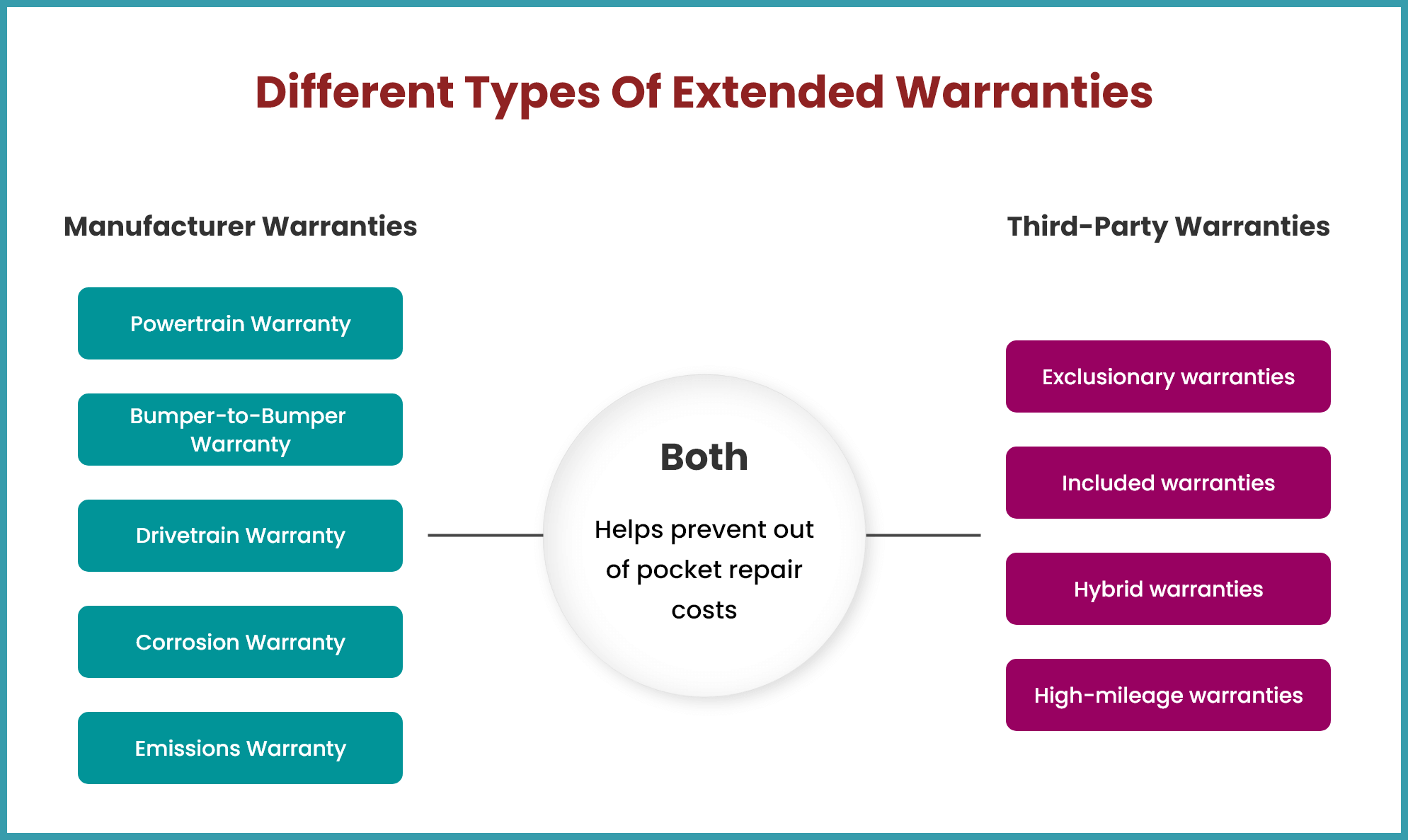
Manufacturer Warranties
Auto warranties, also known as manufacturer’s warranties or factory warranties, provide coverage for specific repairs and services on a vehicle for a predetermined period or mileage, typically offered by the vehicle’s manufacturer.
An extended warranty provided by an OEM will usually offer coverage similar to the new car, extending the coverage duration and the allotted mileage. Some warranty providers may also give some extra benefits like roadside assistance. Manufacturer’s warranties (factory warranties) may differ in what they cover. Ensure you know the vehicle parts it covers before signing the policy.
For instance, some manufacturers may provide an extension of up to 3 years or 1,00,000 km, and others an extension of up to 3 years, covering 3rd year or 80,000 km. The OEM extended warranty comes with or without a deductible. The higher the deductible, the lower the warranty price. Generally, the deductibles are minimal, rarely exceeding $200.
Manufacturer warranty includes the following:
- Powertrain Warranty typically includes the engine block, cylinder heads, and the transmission’s internal parts. Essentially, it takes care of the essential power-producing components.
- Bumper-to-Bumper Warranty covers everything between your vehicle’s bumpers. It includes most parts and systems, from the engine and transmission to electronics, suspension, and more.
- Drivetrain Warranty: This warranty focuses on the components that make your car move, including the transmission, driveshaft, axle shafts, and wheels. It’s a subset of the powertrain warranty.
- Corrosion Warranty: This warranty tackles rust and corrosion of cars. It typically covers the vehicle’s body panels and structure for a specified period, often for its lifetime.
- Emissions Warranty: This comes into play when your vehicle’s components cause it to fail government emissions tests. This warranty covers repairs to components like the catalytic converter and oxygen sensors.
Know more about factory warranty and how it can protect your new vehicle.
Third-Party Warranties
Most third-party or so-called aftermarket warranties provide similar coverage as OEM warranties. However, unlike OEM warranties, some types may have exclusions, limitations, and requirements. Some third-party warranties may require you to pay for a replacement or repair and file a claim for reimbursement.
There are different types of third-party warranties available in the marketplace, such as:
- Exclusionary warranties, sometimes called “exclusionary coverage,” only list the parts and components not covered in the plan. Every other part not listed in the part gets automatically covered. This type of warranty suits budget-conscious individuals or those primarily concerned with covering specific components.
- Included warranties, or “inclusionary coverage,” cover a defined list of components explicitly stated in the contract. Contrary to exclusionary warranties, this type of warranty only lists parts covered in the plan. The plan will automatically not cover the parts and components not mentioned in the list.
- Hybrid warranties combine features of both exclusionary and included warranties. They typically cover a specified list of components while covering certain other components if their failure stems from a defect in a covered component. This type of warranty provides a broader range of protection than exclusionary warranties.
- High-mileage warranties are specifically designed for vehicles with accumulated mileage exceeding the average. They generally cover a narrower range of components than other warranty types but can still offer value for higher-mileage vehicles.
Inclusions And Exclusions In An Auto Warranty Coverage
While offering valuable protection, auto warranties can come with many inclusions and exclusions that can bewilder even the savviest car owner. So, buckle up and get ready to unlock the mysteries of your auto warranty.
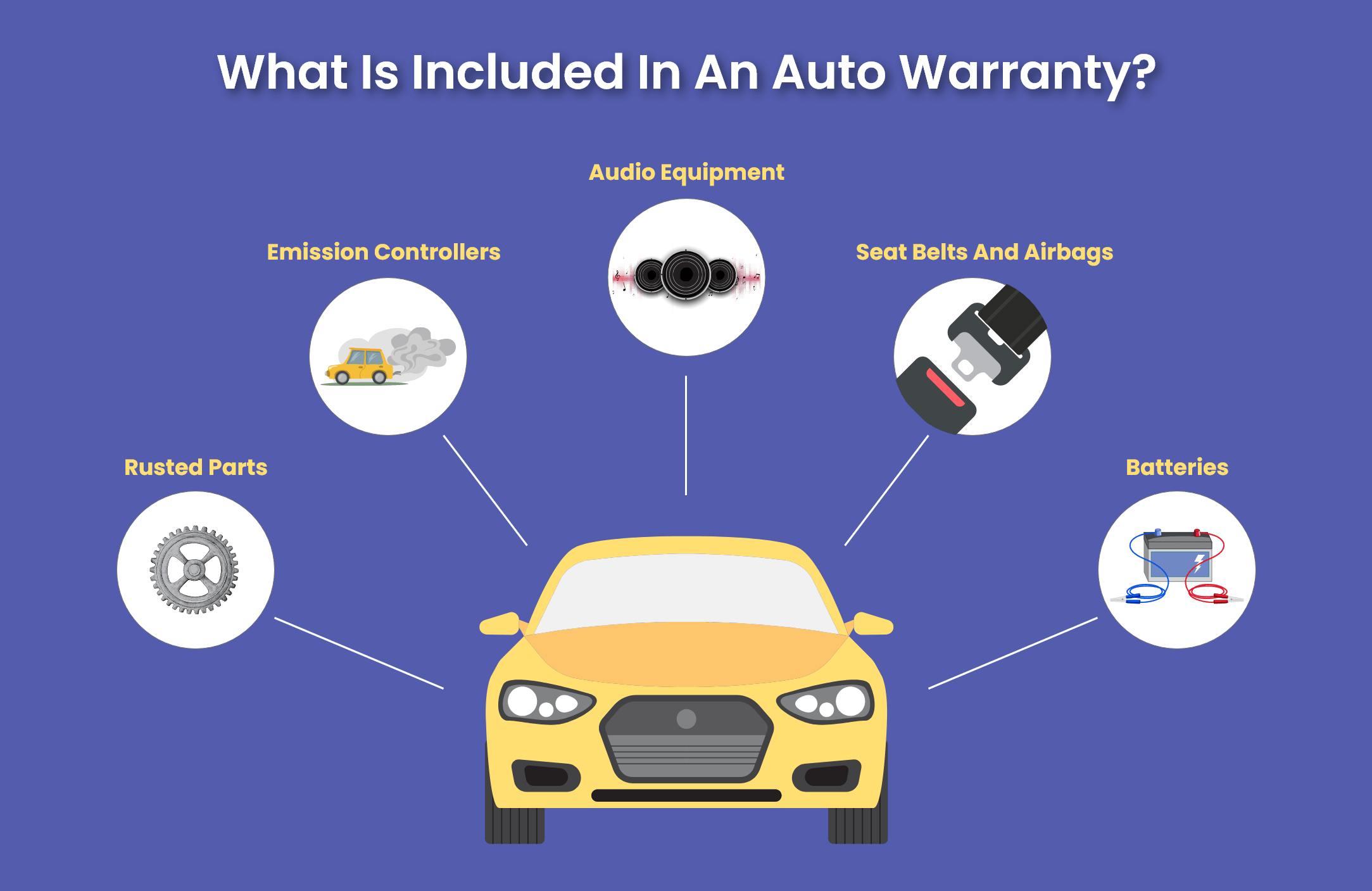
What Is Included In An Auto Warranty?
Here is a list of items that most auto warranty providers in the market often cover:
Rusted Parts
The warranty covers body panels that have rusted through obsoleteness and age. Some policies last up to six years without mileage limits. However, the warranty covers only the complete perforation of your vehicle parts, which is rare with rust-proofing technologies. Most warranties don’t cover rust caused by acid rain, rock chips, or hail.
Emission Controllers
For emission controllers such as oxygen sensors & catalytic converters, two types of warranties exist- a design & defect warranty. These warranties cover your vehicle for two years or 24,000 miles if your vehicle fails in emissions control tests.
Another is a performance warranty that covers your vehicle for at least two years if it fails an emissions test. This policy covers significant parts, such as engine control modules, for performance and defects.
Audio Equipment
Most manufacturers’ warranties cover audio devices provided an authorized dealer installs them. A defective or broken audio component must be taken out of your vehicle before it is sent back for repair or replacement, but you have to pay to take the device out and put it back into your vehicle.
Seat Belts And Airbags
Some automobile makers include seat belts and airbags with bumper-to-bumper or powertrain warranties; others make separate policies. Generally, seat belts are covered for operating usability only, not for other cosmetic defects.
Batteries
If not covered in the bumper-to-bumper warranty, your vehicle’s conventional battery may get its own warranty. Battery warranties range from 2 to 3 years and cover defective batteries on a prorated basis.
What’s Not Covered In A Car Warranty?
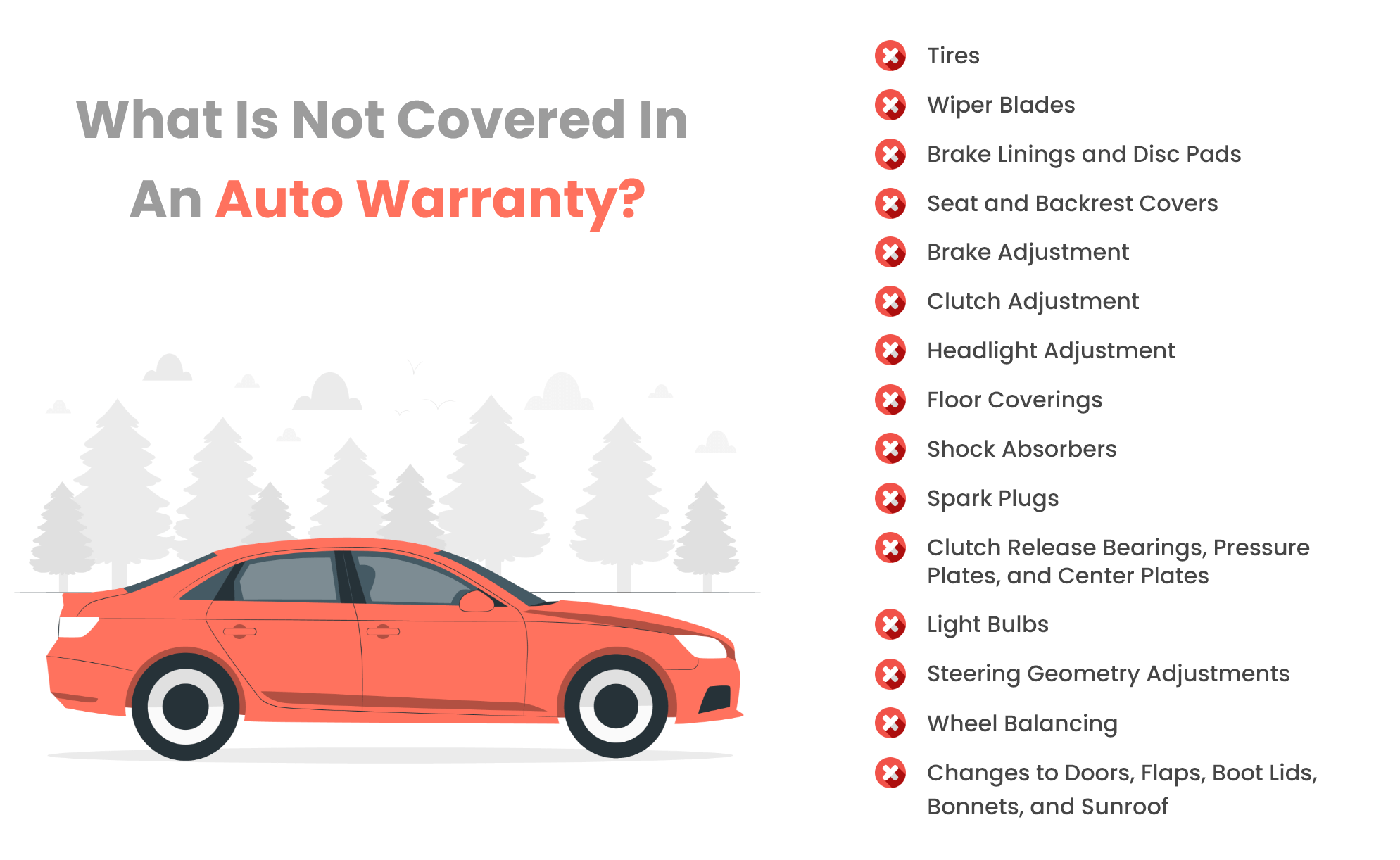
These items are generally not covered by standard manufacturer warranties:
- Tirues: Damage or wear to tires is typically not covered, even due to a manufacturing defect.
- Wiper Blades: Wiper blades are considered worn items and are usually not covered.
- Brake Linings and Disc Pads: Brake components, such as brake pads and linings, are considered wear items and are typically excluded from warranty coverage.
- Seat and Backrest Covers: Cosmetic elements like seat and backrest covers are generally not covered.
- Brake Adjustment: Adjustments and maintenance for brakes, such as brake adjustments, are often not included.
- Clutch Adjustment: Similar to brakes, adjustments for the clutch are usually not covered.
- Headlight Adjustment: Adjustments to headlights are typically not covered by warranties.
- Floor Coverings: Issues with interior floor coverings are typically excluded from warranty coverage.
- Shock Absorbers: While some parts of the suspension system may be covered, shock absorbers are often considered worn items and may not be covered.
- Spark Plugs: Consumable items like spark plugs are generally not covered.
- Clutch Release Bearings, Pressure Plates, and Center Plates: Components related to the clutch system are often considered worn items and may not be covered.
- Light Bulbs: Replacement of light bulbs, such as those for interior or exterior lights, is typically not covered.
- Steering Geometry Adjustments: Adjustments to the steering geometry are generally not covered by warranties.
- Wheel Balancing: Routine wheel balancing is typically not included in warranty coverage.
- Changes to Doors, Flaps, Boot Lids, Bonnets, and Sunroof: Alterations to vehicle components, such as doors, flaps, boot lids, bonnets, or sunroofs, are typically not covered unless they are due to a manufacturing defect.
A basic warranty may or may not cover the aspects you are looking for, but remember, every policy is negotiable, provided your preferences and the manufacturer’s meet. Ensure to go through all the terms and conditions given in the policy before signing it to avoid any future problems.
Factors To Consider When Choosing A Third-Party Auto Warranty
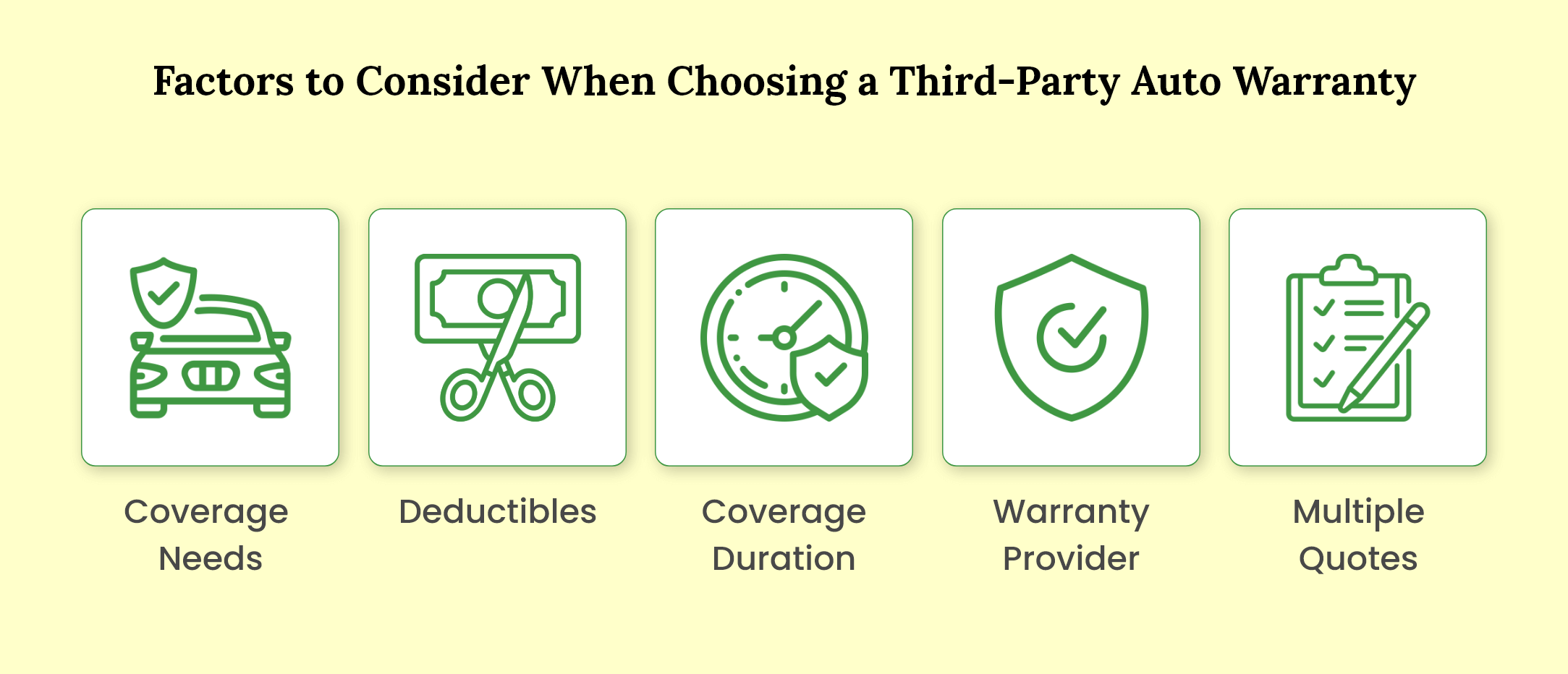
Here are some of the factors you should consider while looking to get an auto warranty:
- Coverage Needs: Assess your coverage requirements based on your budget and concerns regarding specific components.
- Deductibles: Deductibles represent the out-of-pocket expenses you incur for each repair. Opt for a warranty with a deductible you can comfortably afford.
- Coverage Duration: Select a warranty that aligns with the duration you intend to own the vehicle.
- Warranty Provider: Ensure the chosen warranty provider is reputable and boasts a positive customer service track record.
- Multiple Quotes: Obtain quotes from various providers to compare prices and coverage details.
How Much Do Extended Car Warranties Cost?
The price of extended car warranties is open to negotiation and variable. It varies based on the chosen plan and your car model. Typically, the upfront cost falls from $1,000 to $3,000. However, additional fees and interest amounts may apply if the warranty is bundled with your auto loan.
Regarding deductibles with an extended warranty, you may have to pay in one of two ways: per repair or visit. It’s essential to understand the deductible structure in your plan to prevent multiple deductible payments for related repairs during the same visit. Clarifying this aspect helps you manage costs effectively under the warranty.
Pros & Cons Of An Extended Car Warranty
Buying a car is a big decision, and protecting that investment is crucial. That’s where extended car warranties come in, promising peace of mind in exchange for your hard-earned cash. But are they truly a shield against unexpected breakdowns, or just an expensive gamble? Let’s explore the pros and cons of investing in an extended car warranty in detail.
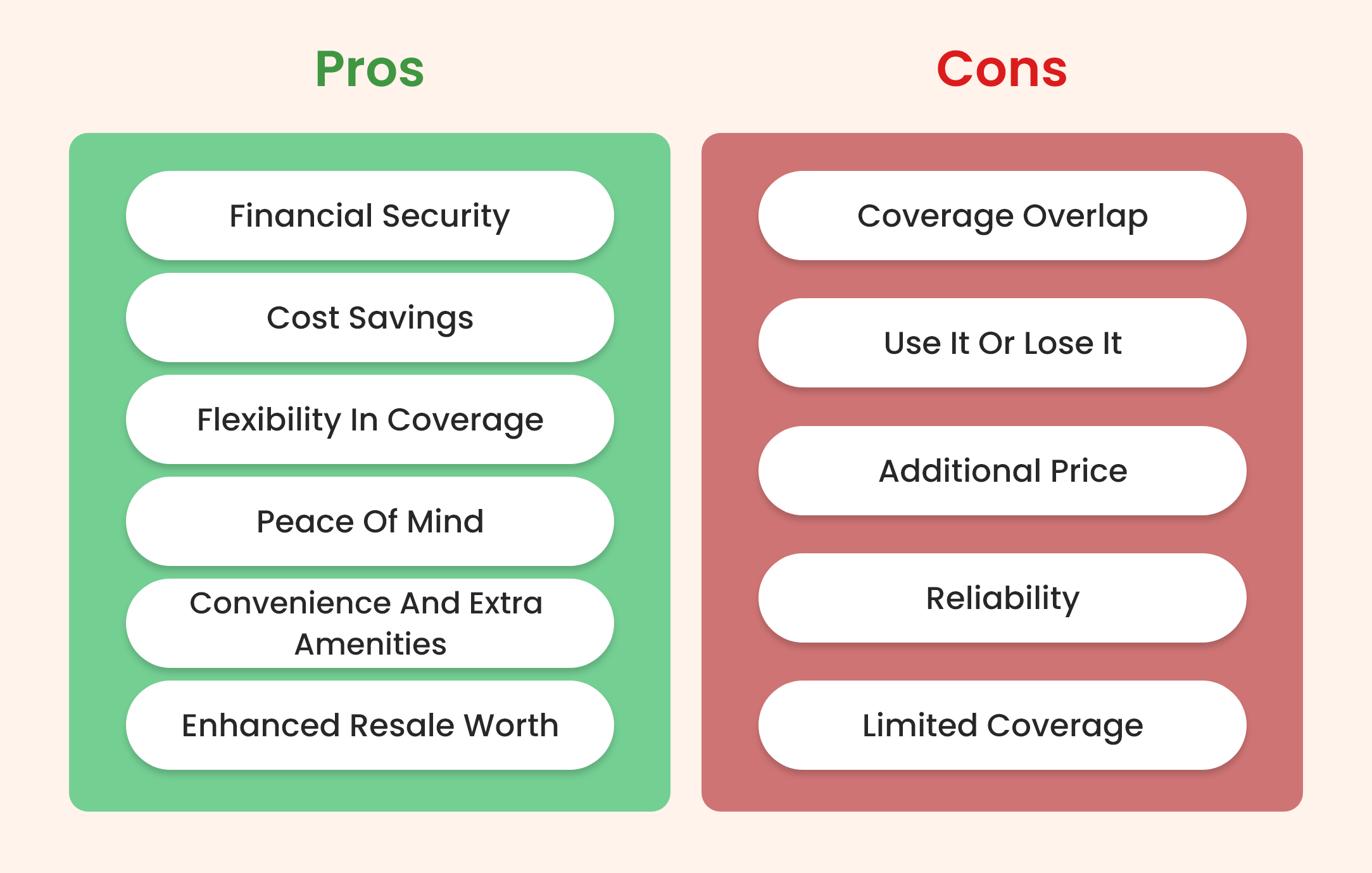
Pros Of An Extended Car Warranty
Extended warranties, often vehicle service contracts, are designed to mitigate financial burdens resulting from unexpected repairs and maintenance.
There are several advantages of extended warranty, making it an appealing option for vehicle owners:
- Financial Security
An extended warranty serves as a financial protection in case of costly repairs. If a component covered by the warranty malfunctions, you’ll only need to pay the deductible, relieving you from bearing the entire repair cost. The warranty provider handles the remaining repair expenses.
- Cost Savings
Choosing an extended warranty could lead to substantial long-term savings. The coverage provided by the warranty can mitigate costly repair charges, preventing unexpected repairs from burdening your finances. Know how an extended warranty can help you save and protect your investment.
- Flexibility In Coverage
Extended warranties frequently offer versatility in their coverage, enabling you to personalize the plan to match your precise needs. You can select the extent of coverage and the components you wish to safeguard, tailoring it to meet your specific requirements.
- Peace Of Mind
Knowing that an extended warranty covers your car gives you peace of mind. Without the worry of being severely financially strained by unforeseen repairs or replacements, you can drive with confidence.
- Convenience And Extra Amenities
Numerous extended car warranties offer supplementary conveniences like roadside support, tow services, rental car provisions, and assistance for trip disruptions. These additional features enhance the value and assurance for the vehicle owner.
- Enhanced Resale Worth
Extending your warranty can boost your vehicle’s resale worth. Prospective purchasers are more attracted to a vehicle with an ongoing warranty and are often willing to pay a higher price for the extra security it provides.
Cons Of An Extended Car Warranty
Understanding an extended warranty’s potential drawbacks and limitations allows you to make a well-informed decision that aligns with your specific needs and circumstances. Here, we will explore the cons associated with extended warranties.
- Overlap
If the extended warranty period overlaps with the manufacturer’s warranty, you will pay extra for coverage you already have. This often occurs with new cars, where the extended warranty won’t be effected until after the manufacturer’s basic warranty expires.
- Use It Or Lose It
If your vehicle doesn’t require any repairs during the extended warranty period, the money spent on the warranty goes to waste. Even if repairs are needed, but the cost is less than the price of the warranty, you lose out on the excess amount paid.
- Additional Price
The extended warranty does not cover your car’s wear & tear parts. The warranty covers only a few aspects. If uncovered parts require repair, you must spend an extra amount.
Know what an extended warranty covers and how it can benefit you in the long run.
- Reliability
Most extended warranties require the dealer, manufacturer, or third party to pay for repairs. If the entity responsible for paying the bills goes out of business, you will be left with a useless warranty.
- Limited Coverage
Extended warranties often list covered items, and anything not explicitly mentioned is not covered. This limited coverage may leave out essential components or systems, leading to unexpected costs.
Conclusion
In summary, a car’s warranty from the manufacturer is like a safety net, protecting against defects when you buy a new car. Know what it covers to make smart choices for your car’s well-being.
If you plan to keep your car for a while or buy a used one, extra protection from third-party warranties might be a good idea. Understanding these warranties helps ensure your car stays reliable without breaking the bank.




